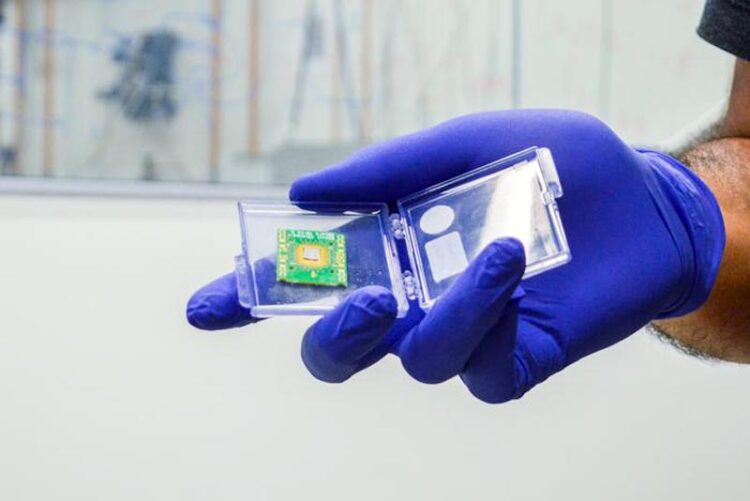New superconducting diode

A University of Minnesota Twin Cities-led team has developed a more energy-efficient, tunable superconducting diode—a promising component for future electronic devices—that could help scale up quantum computers for industry and improve artificial intelligence systems.
Credit: University of Minnesota Twin Cities
… could improve performance of quantum computers and artificial intelligence.
U of M researchers’ device is more energy efficient and versatile than past models.
A University of Minnesota Twin Cities-led team has developed a new superconducting diode, a key component in electronic devices, that could help scale up quantum computers for industry use and improve the performance of artificial intelligence systems. Compared to other superconducting diodes, the researchers’ device is more energy efficient; can process multiple electrical signals at a time; and contains a series of gates to control the flow of energy, a feature that has never before been integrated into a superconducting diode.
The paper is published in Nature Communications, a peer-reviewed scientific journal that covers the natural sciences and engineering.
A diode allows current to flow one way but not the other in an electrical circuit. It’s essentially half of a transistor, the main element in computer chips. Diodes are typically made with semiconductors, but researchers are interested in making them with superconductors, which have the ability to transfer energy without losing any power along the way.
“We want to make computers more powerful, but there are some hard limits we are going to hit soon with our current materials and fabrication methods,” said Vlad Pribiag, senior author of the paper and an associate professor in the University of Minnesota School of Physics and Astronomy. “We need new ways to develop computers, and one of the biggest challenges for increasing computing power right now is that they dissipate so much energy. So, we’re thinking of ways that superconducting technologies might help with that.”
The University of Minnesota researchers created the device using three Josephson junctions, which are made by sandwiching pieces of non-superconducting material between superconductors. In this case, the researchers connected the superconductors with layers of semiconductors. The device’s unique design allows the researchers to use voltage to control the behavior of the device.
Their device also has the ability to process multiple signal inputs, whereas typical diodes can only handle one input and one output. This feature could have applications in neuromorphic computing, a method of engineering electrical circuits to mimic the way neurons function in the brain to enhance the performance of artificial intelligence systems.
“The device we’ve made has close to the highest energy efficiency that has ever been shown, and for the first time, we’ve shown that you can add gates and apply electric fields to tune this effect,” explained Mohit Gupta, first author of the paper and a Ph.D. student in the University of Minnesota School of Physics and Astronomy. “Other researchers have made superconducting devices before, but the materials they’ve used have been very difficult to fabricate. Our design uses materials that are more industry-friendly and deliver new functionalities.”
The method the researchers used can, in principle, be used with any type of superconductor, making it more versatile and easier to use than other techniques in the field. Because of these qualities, their device is more compatible for industry applications and could help scale up the development of quantum computers for wider use.
“Right now, all the quantum computing machines out there are very basic relative to the needs of real-world applications,” Pribiag said. “Scaling up is necessary in order to have a computer that’s powerful enough to tackle useful, complex problems. A lot of people are researching algorithms and usage cases for computers or AI machines that could potentially outperform classical computers. Here, we’re developing the hardware that could enable quantum computers to implement these algorithms. This shows the power of universities seeding these ideas that eventually make their way to industry and are integrated into practical machines.”
This research was funded primarily by the United States Department of Energy with partial support from Microsoft Research and the National Science Foundation.
In addition to Pribiag and Gupta, the research team included University of Minnesota School of Physics and Astronomy graduate student Gino Graziano and University of California, Santa Barbara researchers Mihir Pendharkar, Jason Dong, Connor Dempsey, and Chris Palmstrøm.
Journal: Nature Communications
DOI: 10.1038/s41467-023-38856-0
Method of Research: Experimental study
Article Title: Gate-tunable superconducting diode effect in a three-terminal Josephson device
Article Publication Date: 29-May-2023
Media Contact
Rhonda Zurn
University of Minnesota
rzurn@umn.edu
Office: 612-626-7959
All latest news from the category: Information Technology
Here you can find a summary of innovations in the fields of information and data processing and up-to-date developments on IT equipment and hardware.
This area covers topics such as IT services, IT architectures, IT management and telecommunications.
Newest articles

Parallel Paths: Understanding Malaria Resistance in Chimpanzees and Humans
The closest relatives of humans adapt genetically to habitats and infections Survival of the Fittest: Genetic Adaptations Uncovered in Chimpanzees Görlitz, 10.01.2025. Chimpanzees have genetic adaptations that help them survive…

You are What You Eat—Stanford Study Links Fiber to Anti-Cancer Gene Modulation
The Fiber Gap: A Growing Concern in American Diets Fiber is well known to be an important part of a healthy diet, yet less than 10% of Americans eat the minimum recommended…

Trust Your Gut—RNA-Protein Discovery for Better Immunity
HIRI researchers uncover control mechanisms of polysaccharide utilization in Bacteroides thetaiotaomicron. Researchers at the Helmholtz Institute for RNA-based Infection Research (HIRI) and the Julius-Maximilians-Universität (JMU) in Würzburg have identified a…



